
Astrophotography Color Print Film Tests

NEW! (12/31/2004) Click
HERE for latest
film test results. GREAT
NEWS! Fuji Super HQ200 print film proves to be excellent
for astrophotography!
(4/16/03) Click
HERE to see the results of a
new film, Fuji NPH II 400 color print film! (Update
06/2003: This film has been re-formulated and is no longer useful for
astrophotography.)
This page is dedicated to displaying results of various color print films from the four primary manufacturers (Kodak, Fuji, Agfa, and Konica), of various speeds from 100 to 800ISO. The primary intent of these tests is to use films that are, for the most part, readily available from retail outlets and camera shops. With just a few exceptions, consumer-grade film was preferred over professional-grade film. Also, only films developed with the C-41 process were tested, since these films can be developed at most one-hour shops. NOTE: Subsequent to the original 400 and 800 speed film tests, it was discovered that there are "new" versions of the Konica Centuria 400 and 800. As it happens, the original tests used the "old" 400 and the "New" 800. These were re-tested on 12/9/01, with the reverse true: the "New" 400 and the "old" 800.
Special Note (4/19/03): Don Westergren has a wealth of film test results from testing he has conducted using more controlled "laboratory" conditions, and he has tested both hypered and unhypered films. In many cases, his results on unhypered film show direct correlation to those here that were taken "in the field". See Don's film testing at http://home.nethere.net/mpd/index.htm.
As these tests were being conducted, a decision was made to include a round of tests of C-41 process 400-speed black and white films. C-41 process black and white films, also called "chromogenic", can be taken to any 1-hour shop for processing just like color film. These films are shown at the bottom of the table below.
These film tests are conducted with reasonable scientific rigor. Although each is loaded into a different camera body for convenience and efficiency, all other photographical parameters are identical for each of the three test subjects exposed with each same-speed series of these films.
| Test Subjects: | M31 (Andromeda Galaxy) - test of yellow response | |
| M45 (Pleiades) - test of blue response | ||
| M42 (Orion Nebula) - test of red response | ||
| Exposure Length: | 15 minutes | |
| Focal Length: | f/6.3 | |
| Telescope: | Celestron Celestar Deluxe 8" SCT f/l=2032mm, equatorially mounted | |
| Guide Method: | Hand-guided via Taurus Tracker III off-axis guider | |
| Locations/Conditions: | See bottom for session details | |
Note: None of these photos were intentionally taken for aesthetic value. All were intended ONLY for testing film color and detail response. Some have unacceptable tracking error, some have focus quality problems, some have unusual artifacts since discovered to be from secondary reflections in the optics. That said, a couple of these shots were very good from an aesthetic perspective.
|
|
||||
| Film | Comments | M31 - Andromeda Galaxy | M45 - Pleaides | M42 - Orion Nebula |
| Konica Centuria 100
Camera: Olympus OM-1 Session: 4 |
This film produced horrible results, although the detail captured surpassed that of the other 100-speed films tested. It was the worst of the 100-speed films tested for astrophotography. All three test photos were tinted red. The exact same phenomenon was observed in the 200-speed version of this film. | 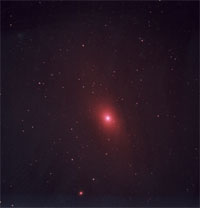 |
 |
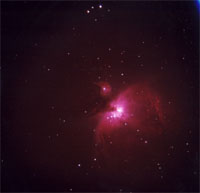 |
| Fuji Superia Reala 100
Camera: Olympus OM-1 Session: 4 |
This film picked up absolutely no reds at all, and very little blue. Yellow was OK. The photo of M42 displayed a strange green tint in the nebulosity. Not recommended. | 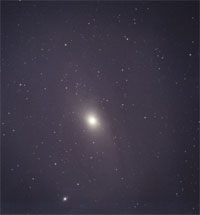 |
 |
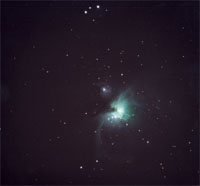 |
| Agfa Vista 100
Camera: Olympus OM-2000 Session: 4 |
This film appeared to pick up red detail, but recorded it in blue. However, the blue response (see M45) is mediocre. This film picked up the least yellow of the 100-speed films tested, as seen in M31. Not recommended. |  |
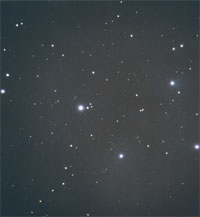 |
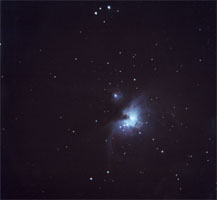 |
| Kodak Supra 100 (Professional)
Camera: Olympus OM-1N Session: 4 |
This film captured decent reds, blues, and yellows. Clearly the best response of the 100-speed films tested, and the only one to produce acceptable results in all three test objects. However, the detail captured in M42 was significantly less than other-speed films and less than the Konica Centuria 100, which captured detail similar to the other-speed films. Detail in M31 was good. | 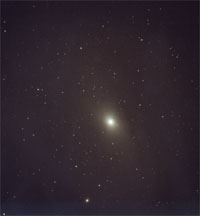 |
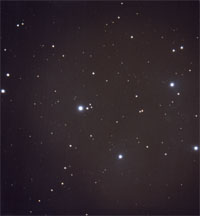 |
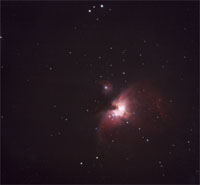 |
|
|
||||
| Film | Comments | M31 - Andromeda Galaxy | M45 - Pleaides | M42 - Orion Nebula |
| Kodak Royal Gold 200
Camera: Olympus OM-1N Session: 5 |
This film captured decent reds, blues, and yellows. This film had the best response of the 200-speed films tested, and was the only one to produce acceptable results in all three test objects. The blue and yellow responses are a bit weak, but overall this film performed admirably. | 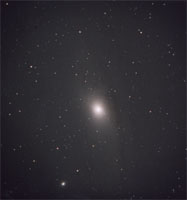 |
 |
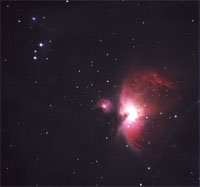 |
| Konica Centuria 200
Camera: Olympus OM-1 Session: 5 |
This film produced horrible results. The detail captured was average or below compared to the other 200-speed films tested. It was the worst of the 200-speed films tested for astrophotography. All three test photos were tinted red. The exact same phenomenon was observed in the 100-speed version of this film. | 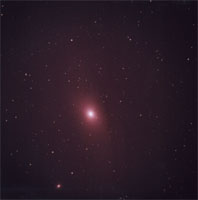 |
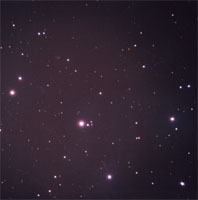 |
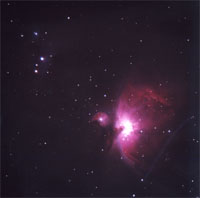 |
| Agfa Vista 200
Camera: Olympus OM-1 Session: 5 |
Like its 100-speed counterpart, this film appeared to pick up red detail, but recorded it in blue. However, the blue response (see M45) is mediocre at best. Not recommended. | 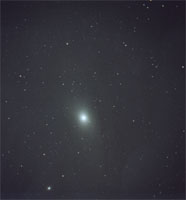 |
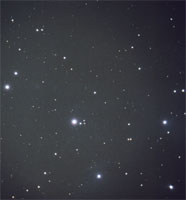 |
 |
| Fujicolor Superia 200
Camera: Olympus OM-2000 Session: 5 |
This film picked up almost no reds at all, but the blue response was similar to that of the Kodak Royal Gold film tested. Yellow was nonexistent; the print of M31 actually appears to be monochrome. Not recommended. | 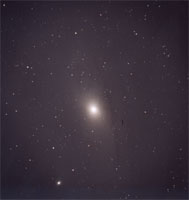 |
 |
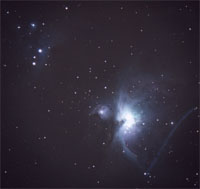 |
|
|
||||
| Film | Comments | M31 - Andromeda Galaxy | M45 - Pleaides | M42 - Orion Nebula |
| Konica Centuria 400 ("old")
Camera: Olympus OM-1 Session: 1 *NOTE: (10/14/01) This film as originally tested was discovered to be the older Centuria 400, produced prior to Konica's announcement in February 2001 of "New" Centuria 400. |
Although this film had the best blue response of the 4 tested films (note M45 and Running Man in M42), it was clearly the worst of the 400-speed films tested for astrophotography. All three test photos displayed unacceptable levels of purple, very unnatural. This is particularly visible in M31. | 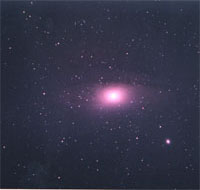 |
 |
 |
| Konica "New" Centuria 400
Camera: Olympus OM-1 Session: 3 *NOTE: (12/9/01) This film replaces the older Centuria 400, and was announced in February 2001. It is distinguished by the "New" on the box. |
The "new" version of Konica Centuria still has a marked purple cast, but only in M42. Blue reponse is OK. Red response is second-worst of the 400-speed films. Good yellow response on M31. Detail in M31 was as good as most other 400-speed films tested. This film is not recommended. | 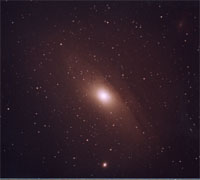 |
 |
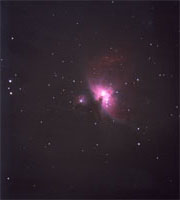 |
| Agfa Vista 400
Camera: Olympus OM-2000 Session: 1 |
Very poor red response in M42, very comparable to current Fuji Superia X-tra 800 (not tested). Photo of M42 was very good, although it lacked most red. Yellow response in M31 was best of the 4 tested films. Blue response in M45 is unremarkable. This film is not the best choice for nebulae. | 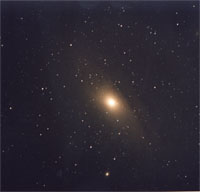 |
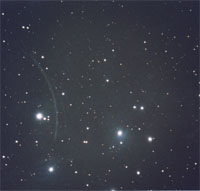 |
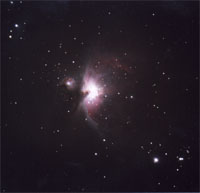 |
| Agfa Optima II 400 (professional)
Camera: Minolta SRT-102 Session: 1 |
Very strong (almost too-strong) red response in M42. Second-best 400-speed film tested for M31 in detail and color. Poor blue response in M45 (would not be a good choice for Trifid Nebula). Second-best 400-speed film tested, for its overall red response. |  |
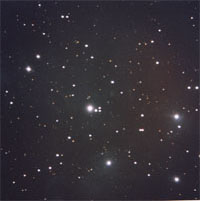 |
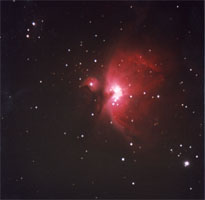 |
| Kodak Royal Gold Select 400
Camera: Olympus OM-1N Session: 1 |
NOTE: (9/3/02) Kodak have changed their film chemistry for this film, and destroyed its usefulness for astrophotography. Click here for a graphic comparison of the "old" and "new" Royal Gold film. NOTE: (4/16/03) Fuji NPH II 400 color print film has recently been tested and has shown to be the best known currently-in-production color print film known by this amateur. Click here for a visual comparison! |
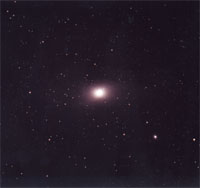 |
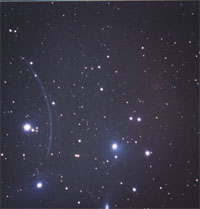 |
 |
| Kodak Max Versatility 400
Camera: Minolta SRT-102 Session: 5
|
This film was tested by special request, due to its prevalence in the consumer market. No red response. Strong blue response, moderate yellow response. Not the best choice for nebulae, but may be OK for clusters and galaxies. |  |
 |
 |
|
|
||||
| Film | Comments | M31 - Andromeda Galaxy | M45 - Pleaides | M42 - Orion Nebula |
| Konica Centuria 800 ("old")
Camera: Olympus OM-1N Session: 3 *NOTE: (12/9/01) This older version of the film was tested due to having a number of rolls on-hand. It is older than the "new" Centuria 800, announced by Konica in February 2001. |
This film showed good red and yellow response, and average blue response. Overall, a good second choice, as it has slightly better red response than Agfa Vista. Overall performance is slightly below that of the "New" Konica Centuria 800. | 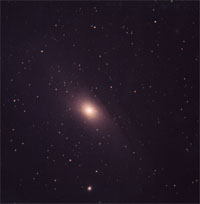 |
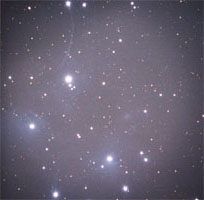 |
 |
| Konica "New" Centuria 800
Camera: Olympus OM-1N Session: 2 *NOTE: (11/10/01) This film as originally tested was discovered to be the "new" Centuria 800, announced by Konica in February 2001. It is distinguished by the "New" on the box. |
This was the best performer of all the 800-speed films tested. Red response is very good. Blue and yellow are also good. This film showed very good across-the-board color response, and nearly matched 400-speed film in graininess. This film would be a great alternative to 400-speed film. | 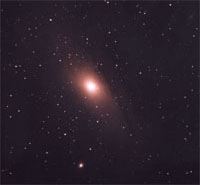 |
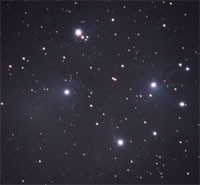 |
 |
| Agfa Vista 800
Camera: Olympus OM-2000 Session: 2 |
Average performance. Red and blue response was moderate. Yellow response was good. Third-best results of the four 800-speed films tested, just behind the "old" Konica Centuria 800. | 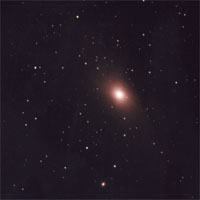 |
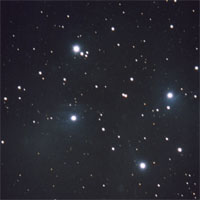 |
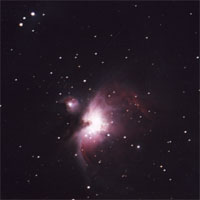 |
| Kodak Supra 800 (professional)
Camera: Olympus OM-1 Session: 2 |
Clearly the worst of the four 800-speed films tested. The M31 photo shows distinct green tint. This green tint has also been observed with Kodak Max Zoom 800 film (not tested). Other photos showed green tint in some stars. Very poor red response. Blue response was very strong, probably contributing to an overall green tint. Not recommended. | 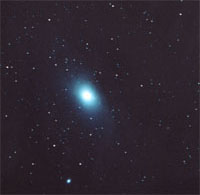 |
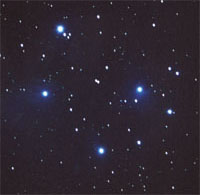 |
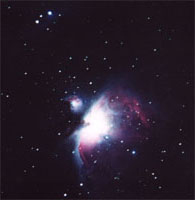 |
| Fujicolor Press 800 (professional)
Camera: Minolta SRT-102 Session: 2 |
Red response is non-existent. Blue and yellow response was OK. This film performed almost identically to 400-speed Agfa Vista (tested above). This film is not a good choice for nebulae. |  |
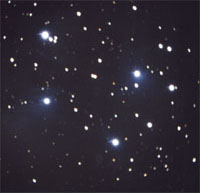 |
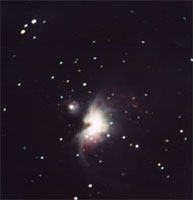 |
|
|
||||
| Film | Comments | M31 - Andromeda Galaxy | M45 - Pleaides | M42 - Orion Nebula |
| Kodak Portra Black and White 400
Camera: Olympus OM-1 Sesson: 6 |
Second-best performer of the chromogenic films tested. Detail was excellent, but all three exposures were somewhat more saturated than the top-performing Ilford XP-2 Super 400. | 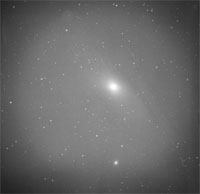 |
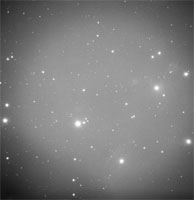 |
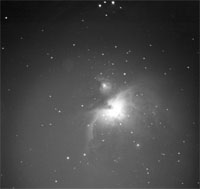 |
| Kodak Professional T400CN
Camera: Olympus OM-1 Session: 6 |
Although the detail captured in M42 was outstanding, the other two exposures were quite saturated and lacking in detail. Not recommended. | 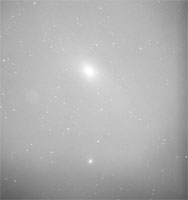 |
 |
 |
| Ilford XP-2 Super 400
Camera: Olympus OM-1 Session: 6 |
This is the best performer of the chromogenic films tested. The detail is good, none of the test exposure were saturated, and the detail captured is excellent. This film is highly recommended. | 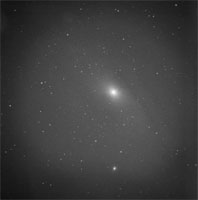 |
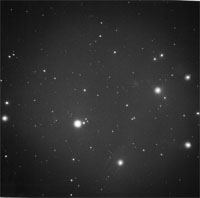 |
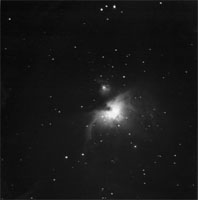 |
| Konica Monochrome VX400
Camera: Olympus OM-2000 Session: 6 |
Average performance compared to the other chromogenic films tested. Detail and saturation were average. | 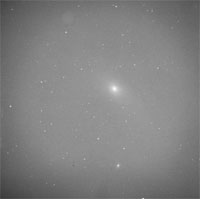 |
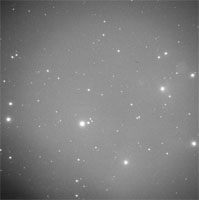 |
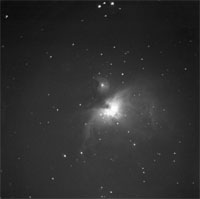 |
| Kodak Select Series Black and White +
Camera: Minolta SRT-102 Session: 6 |
Also delivered an average response in detail and saturation. |  |
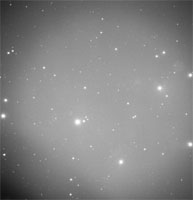 |
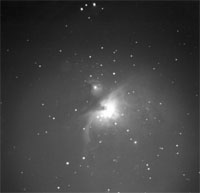 |
|
|
|
| Kodak Royal Gold 400
Close-up of Horsehead Nebula (Orion), Scanned at 9600dpi from original 4x6 print (Note sharper definition) |
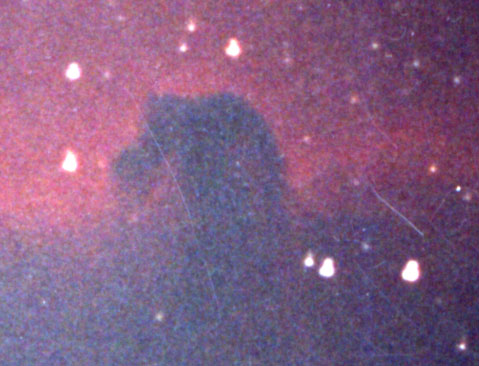 |
| Konica "New" Centuria 800
Close-up of Horsehead Nebula (Orion), Scanned at 9600dpi from original 4x6 print (Note softer definition) |
 |
| Kodak Royal Gold 400
Close-up of the Pleiades (Taurus), Scanned at 300dpi from original 4x6 print (Note detail and sharpness) |
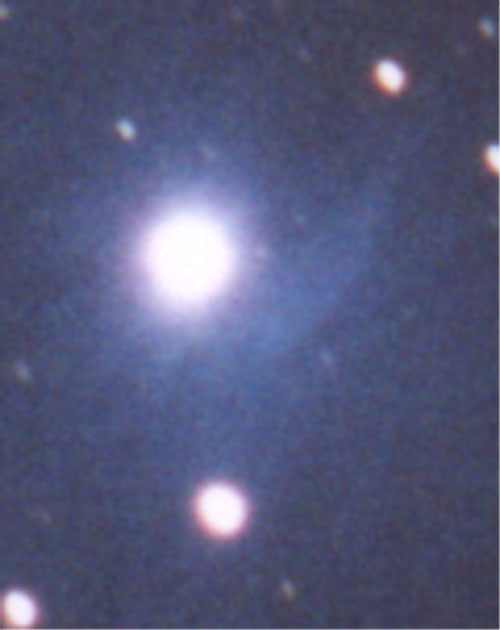 |
| Konica "New" Centuria 800
Close-up of the Pleiades (Taurus), Scanned at 300dpi from original 4x6 print (Note softer definition) |
 |
| Agfa Vista 800
Close-up of the Pleiades (Taurus), Scanned at 300dpi from original 4x6 print (Note softer definition, especially compared to Konica "New" Centuria 800) |
 |
Comments on the Results
Special Note on film choices: Kodak Portra film was specifically avoided in all speed categories except for the black and white category, due to abundant anecdotal evidence that these films are uniformly unacceptable for astrophotography. Also, given a choice between consumer and professional films, a preference was shown for the consumer versions except where previous unscientific experience with the consumer version (as in the cases of Kodak Max Zoom 800 and Fujicolor Superia X-tra 800) had already indicated unfavorable results. Kodak "Gold" films were all avoided, as was Kodak Royal Gold 100, due to Kodak having recently discontinued them. The "Gold" films have apparently been repackaged as the "Max" films, but only the 400-speed version was tested and that was due to special request.
100-speed films: Aren't 100-speed films too slow to use for astrophotography? These results indicate that the answer is, in a word, no. That said, very high reciprocity failure was observed in the top-performing 100-speed film, Kodak Supra 100. Other test exposures taken with this film of M42 at 5, 10, 15, 22, and 30 minutes showed very little difference in detail, especially beyond 15 minutes. Similar results were observed with test exposures of M31 and M45 at 5, 10, and 15 minutes. However, the grain of 100-speed films is generally accepted to be among the finest and it enlarges exceptionally well. Overall, though, the results in the four test films was somewhat disappointing compared to those of the 200, 400, and 800-speed films.
200-speed films: These offer a decent compromise between reasonable exposure lengths and finer grain. The reciprocity failure seen in the 100-speed films was also observed to a lesser degree with these films. Compared to 400 and 800 speed films, these films delivered good detail, and the top-rated Kodak Royal Gold 200 was at least as good as the top 400 and 800 speed films in terms of detail, color, and grain. Also, the films tested tended not to display the odd color shifts seen in several of the 100-speed films. This would make them decent choices for photography of galaxies and clusters where no nebulosity is found (except for the Konica Centuria 200, which is unacceptable for any objects) .
400-speed films: Why 400-speed films? Two words: Less Grain than "faster" 800-speed films, which makes for cleaner enlargements and sharper photos. Also, it's been reported that 800ASA and faster films tend to perform no better than 200ASA films after 10 or 15 minutes of exposure. To test this theory, after the test exposures on these four films was completed for the analysis above, a test photo of the Horsehead Nebula (IC434) in Orion was exposed for 30 minutes using the Kodak Royal Gold Select 400 film. On a nearby 10" SCT, 24 and 30 minute exposures of the same region were exposed using Kodak Royal Gold 1000 film. The results were very interesting. The 400ASA photo showed exactly as much color and detail as the 1000ASA photos. There was also no discernable difference between the 24 and 30 minute photos on the 1000ASA film. Conjecture is that the 1000ASA film stopped recording anything appreciable after 15 or 20 minutes. And the 400-speed film photo showed FAR LESS GRAIN.
800-speed films: Why test 800-speed films when 400-speed and 100-speed films have less grain? The promise of shorter exposures lengths. The 800-speed film tests were a very good comparison to the 400-speed films tested one month earlier. During the 800-speed film tests above, an additional 30-minute exposure of the Horsehead region of Orion was taken with the Konica Centuria 800, which has been reported elsewhere to have very fine grain. This was compared directly to a 30-minute exposure of the same region one month earlier with Kodak Royal Gold 400. The results: differences in grain were very difficult to find under a 10x loupe, although a slight edge was given to the KRG 400. Additionally, the KRG color was a bit more vibrant. It also subjectively "just looked sharper" than the Konica "New" Centuria 800 in a side-by-side visual comparison. In comparing the graininess of the various 800-speed films against those of the 400-speed films tested one month earlier, grain in the 800-speed films were generally more noticeable under the 10x loupe, although the Konica showed very fine grain. Also, color and detail recorded by the 800-speed films for the 15-minute test exposures was almost identical to those of the 400-speed films tested at the same exposure lengths. There was very little difference between the two film speeds for a 30-minute test photo of the Horsehead region of Orion. Therefore, it's difficult to support the notion that the 800-speed films will produce the same results with shorter exposure lengths.
Black and White films: These films made for an interesting comparison to those in the color speed categories. All known available chromogenic films were tested, without regard to the general criteria that had been used to select the color films. In most cases, the detail captured was about equivalent to those of the top-rated films in each of the color speed categories. These films seemed to display uneven exposure-length results across the tested objects. One obvious conclusion from that is that frequent use would require some special work to test exposure lengths on a broader selection of test objects in order to avoid oversaturation that appeared in several of the test exposures shown here.
Conclusion/Recommendations:
The table below summarizes the recommendations for films at the
different
speeds, as well as films to avoid. It's interesting to note the
flip-flop
between Kodak and Konica in the 800-speed category, as compared to the
100, 200,
and 400 speed categories.
| Speed Category | Recommended | Avoid |
| 100ASA | Kodak Supra 100 | Konica Centuria 100 |
| 200ASA <SEE UPDATE> | Konica Centuria 200 | |
| 400ASA <SEE UPDATE> | Konica Centuria 400 ("New" or "Old") | |
| 800ASA | Konica "New" Centuria 800 | Kodak Supra 800 |
| Black and White (Chromogenic) | Ilford XP-2 Super 400 | Kodak Professional T400CN |
UPDATE: (9/3/02) Kodak have changed their film chemistry for this film, and destroyed its usefulness for astrophotography. Click here for a graphic comparison of the "old" and "new" Royal Gold film.
UPDATE:
(4/16/03) Fuji NPH II 400 Color Print Film has recently been
tested and compared to previous favorite films, with quite
favorable results.
Click here for a visual
comparison!
NOTE (06/2003): Fuji have
re-formulated this film and it is no longer suitable for
astrophotography.
NEWEST UPDATE: (12/31/04) Fuji
Super HQ200 has been tested and proved to be be quite good for
astrophotography. Click
HERE for
results!
|
Locations / Conditions of Test Sessions |
||
| 1. 400-Speed Film Test: | ||
| Location: | Rush Run State Wildlife Area, Preble County, Ohio (10-14-01 / 10-15-01) | |
| |
Weather Conditions: | Clear, occasional 5mph breeze, 37-50 degrees, high humidity |
| |
Seeing Conditions: | Very transparent, steady to somewhat unsteady |
| |
Limiting Magnitude: | Mag 6.0 with east and south light domes to 30 degrees |
| |
Date of Session: | 10-14-01 |
| 2. 800-Speed Film Test: | ||
| Location: | Tranquility State Wildlife Area, Adams County, Ohio (11-10-01 / 11-11-01) | |
| |
Weather Conditions: | Clear, occasional 5mph breeze, 34-50 degrees, moderate humidity |
| |
Seeing Conditions: | Transparent, somewhat unsteady |
| |
Limiting Magnitude: | Mag 6.4 (constant), 7.4 (occasional), no light domes in any direction |
| |
Date of Session: | 11-10-01 |
| 3. 400/800 Konica Re-Test: | (400 "New" and 800 "old") | |
| |
Location: | Caesar Creek State Park (50 Springs Area), Warren County, Ohio (12/9/01) |
| |
Weather Conditions: | Clear, 23-30 degrees, moderate humidity |
| |
Seeing Conditions: | Transparent, steady |
| |
Limiting Magnitude: | Mag 5.0, light domes in east, southwest, west, north |
| |
Date of Session: | 12-9-01 |
| 4. 100-Speed Film Test: | ||
| Location: | Home yard, Springboro, Warren County, Ohio (12-11-01) | |
| |
Weather Conditions: | Clear, occasional 5mph breeze, 30-40 degrees, moderate humidity |
| |
Seeing Conditions: | Transparent, steady |
| |
Limiting Magnitude: | Mag 4.8, light domes in northwest, north, northeast, and neighborhood lights (shielded) |
| |
Date of Session: | 12-11-01 |
| 5. 200-Speed Film Test: | ||
| Location: | Home yard, Springboro, Warren County, Ohio (12-20-01) | |
| |
Weather Conditions: | Clear, occasional 5mph breeze, 25-35 degrees, low humidity |
| |
Seeing Conditions: | Transparent, steady |
| |
Limiting Magnitude: | Mag 4.8, light domes in northwest, north, northeast, and neighborhood lights (shielded) |
| |
Date of Session: | 12-20-01 |
| 6. Black and White 400-Speed Film Test: | ||
| Location: | Home yard, Springboro, Warren County, Ohio (12-21-01) | |
| |
Weather Conditions: | Clear, occasional 5-10mph breeze, 25-35 degrees, moderate humidity |
| |
Seeing Conditions: | Transparent to occasionally hazy, somewhat unsteady |
| |
Limiting Magnitude: | Mag 4.8, light domes in northwest, north, northeast, and neighborhood lights (shielded) |
| |
Date of Session: | 12-21-01 |